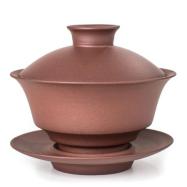
Make room in your cupboard right now!
We all know there are a myriad of gadget’s out there in which to brew tea. I’m admitting to you now that I am a complete sucker, when I see or hear about something that’s been touted as the latest, greatest and the simplest way to brew tea and then of course I JUST HAVE TO HAVE IT!
So call me what you will – a pushover, a dupe, a chump , a sap etc. – and that’s why I have several shelves in one of my kitchen cupboards, that houses various “tea brewing vessels”, that were advertised as the latest, the greatest and simplest way to brew tea and needless to say they WERE NOT the greatest and simplest way to brew tea – money down the drain !
But there is one brewing vessel that I have and use, that I want to introduce to you, and that is – a traditional Chinese tea brewing vessel comprised of three parts. gaiwan. My first experience with this particular tea brewing vessel, was years ago when I took my very first tea course. However, I’ll tell you this, it’s NOT the simplest way to brew tea, but we’ll get to that a little later.
Some back- ground information…
Though the first gaiwan’s date back to the Ming Dynasty, just around the same time as the first teapots, the “lidded” bowl never caught on world -wide with the same fervor. During the Ming Dynasty when loose leaf teas came into fashion, it was the preferred vessel for appreciating the aroma of various fragrant teas. Today, the close association between gaiwan’s and Chinese teas gives them an exotic reputation that can and is intimidating for new users, but they are a practical tool for both everyday brewing and serous tea tasting. During the Ming Dynasty it was exceedingly popular to drink tea directly from it. Tea drinkers would hold the gaiwan in one hand and then use their other hand to brush away the floating tea leaves. Today the gaiwan remains one of China’s most popular tea tools. Gaiwan’s are still used today in all China tea houses as well as by tea tasters in factories and research centers.
The gaiwan consists of three pieces.
- a saucer that holds the cup
- a small cup with a flared lip
- and a lid for the cup

The lid allows the tea to be brewed right in the cup and holds back the leaves while drinking, or the brewed tea can be poured into a separate cup or small teapot. The saucer is used to bring the cup to your lips without having to handle the hot cup and believe me the cup is hot!
Ancient Chinese tea masters told of the symbolism of the three pieces: the lid representing heaven above, the saucer representing earth supporting below, and the bowl representing humans living in between. Meditations and reflections on the harmony and unity of these three elements (heaven, earth, and humans) is a common theme throughout Chinese poetry, art, and philosophy throughout history.
Using it because…
Gaiwan’s allow us, the tea drinker, to re-infuse our leaves numerous times. They are most used for oolong, green, white, and pu-erh teas. Not my brewing vessel, because black teas don’t retain their flavor for repeated steeping’s and as I said before black teas are my favorite. They also allow for greater control when steeping because the leaves float freely in the gaiwan, and you can watch them dance as they unfurl, releasing their full flavor.
But…
Using it can be challenging in the beginning. In my experience, one of the most intimidating aspects of using a gaiwan, is figuring out how to hold it as you pour, without burning your fingers. So, picture this -all three parts are held at once with both hands. The saucer is held with the fingers of your right hand while your thumb rests on the edge of the bowl. Your left hand then holds the lid, which is used to brush away the tea leaves before drinking. Trust me when I say this – it takes A LOT OF PRACTICE, and I mean a lot of practice to do this, without burning your fingers and dropping the hot cup and saucer!!
